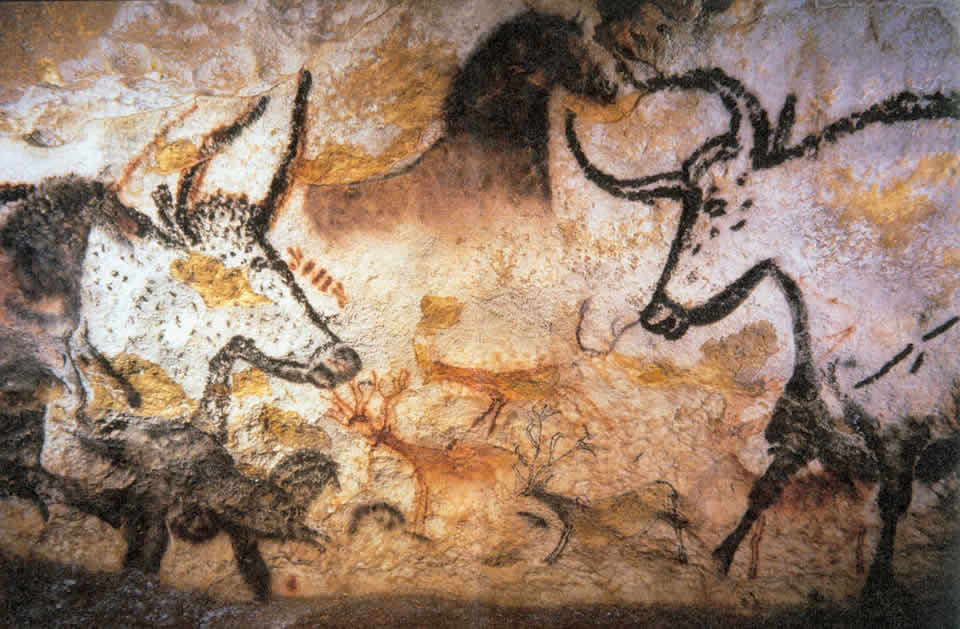Is it possible to recreate the language of Stone Age man, spoken between 30,000 and 100,000 years ago? Some linguists believe it is. There is a small group of researchers who have traced words for key concepts in human life all the way back to a period when, they believe, the first language originated. They also believe that out of that first language, all the 6,000 other languages on Earth emerged.
Many modern languages show some obvious similarities in the words they contain and the grammatical structures they use. Italian and Spanish, French and Romanian, Russian and Serbo-Croat, Norwegian and Danish are all examples.
In the 19th century it became clear that there were wider and subtler connections, and languages were organized into families containing members that were not obviously similar at all – English and Sanskrit, for example, are members of the Indo-European family of languages. These ‘family trees’ were not organized on the basis of a hunch, but through the discovery of rules showing that words that appeared different in the way they were spelled or pronounced were actually derived from a common source. One of these rules, called “Grimm’s Law”, explained how words beginning with ‘f’ in some European languages turned out to be derived from words beginning with ‘p’ in older languages like Greek and Latin. ‘Pus’ (Greek) and ‘pedis’ (Latin) led to foot, fuss and fod in English, German and Swedish. Similar changes occurred from b to p, g to k, and other sounds.
Using these rules and comparing, say, English mouse, German Maus, Swedish mus, Russian mys, Polish mysz and Greek mys, linguists could ‘reconstruct’ the word for mouse in proto-Indo-European as – not very surprisingly – mūs.
But the Indo-European languages are just one group, with similarities that are often easy to observe, and they seem very different from the languages spoken in China, or among North American Indians. What if, as some linguists believe, there existed a Proto-World language, from which all human languages emerged? How could this be reconstructed?
In fact, this has been done for a small number of words, using similarities between language families, instead of between individual languages. One larger language family is called Nostratic, named after the Latin expression for the Mediterranean, “Mare Nostrum”, around which some of the languages derived from it are now spoken. But the Nostratic languages cover a much wider area today, and include a high proportion of the language families of Europe, Asia, Africa and North America.
By looking at words meaning ‘seed’, ‘grain’, ‘wheat’ or ‘barley’ in a range of modern languages, the linguists have inferred that in the original Nostratic there was a word, ‘bar’ or ‘ber’, giving rise to far (Latin), barley (English), burr (Arabic), paral (Malayalam) and a number of other words with similar meanings in African and Indian languages, as well as Mediterranean ones.
To many linguists, the approaches of these ‘Nostraticists’ are often seen seen as dubious. However Joseph Greenberg, a pioneer in the field, believes the techniques are rigorous. For him, the next obvious step is to see whether the proto-languages can themselves be grouped into families, with the ultimate aim of tracing all languages back to one Proto-World language.
The theory that all languages are descended from a single starting point is not implausible, and is accepted by many linguists. But what the critics say is that that language is now too buried in the past to reconstruct or to find methods to prove that it existed.
To the proponents of the world language, the methods they use are rigorous and statistically valid. They are as sure that there were people who said kuni for woman or wete for water. Their arguments are often based on an impressive list of similar-sounding words discovered in many different languages, too many similarities to have occurred by chance, they say.
One linguist, Merritt Ruhlen, has no difficulty finding examples across the entire spectrum of world languages which suggest a common link. He gives as an example the word ‘man’ in English and finds the following examples across a wide range of languages.
| Modern Examples of the word ‘man’ | |
|---|---|
| Word | Language |
| mani | Bantu language Mbudikum-Bamum |
| me’en | East Sudanic |
| mino | Omotic |
| mn | Cushitic |
| manus | Avestan |
| manja | Gondi |
| munan | Indo-Pacific |
| man | Amerind (Bella Coola) |
| mina | Old Japanese |
For a glimpse of what Palaeolithic mano or kuna might have been saying 30,000 years ago, here are some words of that first world language, as reconstructed by this new school of linguists:
| Reconstructed Palaeolithic words | |
|---|---|
| aja (mother) | aqwa (water) |
| bunka (bend) | bur (dust) |
| kano (arm) | kama (hold) |
| kati (bone) | kolo (hole) |
| kun (who?) | kuna (woman) |
| mako (child) | mana (stay) |
| mano (man) | min (what?) |
| par (fly) | poko (arm) |
| teku (leg or foot) | tika (earth) |





